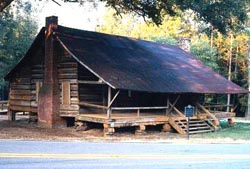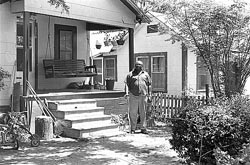West of the Ouachita: Conserving the Heritage of the Pine Hills and River Valleys of Northwest Louisiana
By Susan Roach
Often people unfamiliar with Louisiana stereotypically consider the whole state to be made up of French-speaking Cajuns, Catholics, and swamps; however, this misconception overlooks the fact that Louisiana is divided geographically, ethnically, and philosophically into two main regions. Predominantly Protestant, North Louisiana is culturally part of the upland and riverine US South. Scholars have suggested a number of boundaries between south and North Louisiana, using various mappable cultural traits such as French/English differences, Catholic/Protestant religious differences, liberal/conservative voting preferences, and differences in material cultural objects such as houses. When these various boundaries are overlaid, a composite boundary is seen to begin in the southwest corner of the state, north of where the Sabine River empties into the Gulf, and runs northeast to the point where the thirty-first parallel crosses the Mississippi (in northern Avoyelles Parish) and then runs southeast through the mouth of the Mississippi. (See the map in the center of this program book).
North Louisiana's mainly rural folk landscape was shaped by contacts among Native Americans, African Americans, and Anglo-Celtic Americans in pioneer, plantation, sharecropping, and small farm settings in the river bottomlands, piney woods, and hills of the region. In addition, other cultural groups in the area include Creoles in the Cane River area below Natchitoches, Spanish-speaking people, some of whom are of Choctaw-Apache descent, who live on what is now the Louisiana/Texas border, and a number of smaller population groups. In 1994, the Cane River area became home to an historical park and heritage area under the National Park Service set up to preserve significant landscapes, sites, and structures associated with the development of Creole culture. The Oakland Plantation and various outbuildings of the Magnolia Plantation are included within the National Historical Park. The Heritage Area includes the Cane River corridor, the historic district within the town of Natchitoches, and Fort Jesup and Las Adaes site to the west. In all, North Louisiana can also be broken down into a number of smaller geographical regions, and anthropologist H.F. Gregory has likened the area to a strip quilt made up of many separate, textured pieces. While the Delta and even such far-flung regions of the state as the Florida Parishes are culturally "northern," I will concentrate here on the subregions of the hill parishes and river valleys of north central and northwestern Louisiana.

Interestingly, while many people think that this portion of the northern region of the state is not culturally important, in actuality, research is finding it to be as traditional as any other part of the state. Since the establishment of the Louisiana Folklife Program within the Louisiana Division of the Arts in 1978, projects focusing on folk traditions in North Louisiana reveal viable traditions ranging from music such as old-time country fiddling, blues, and gospel; to crafts such as white-oak basketry, quilting, and hoop net-making; to foodways such as cooking cornbread and butterbeans, canning mayhaw jelly, and curing pork.
Research by folklorists and other cultural specialists on these folk traditions in the subregions of North Louisiana has resulted in exhibitions, record albums, festivals, and publications. Scholars often see these attempts at identifying, preserving, and presenting folk traditions as positive examples of cultural intervention because these projects not only conserve such traditions but also, in turn, may influence those traditions which they have documented. To that end, in recent years, agencies and scholars on both the regional and state levels have been working to provide documentation of north Louisiana folk culture.
The longest running has been the Louisiana Folklife Center at Northwestern State University in Natchitoches. Under the direction of Don Hatley, the Center conducted and archived research on much of the northern part of the state and has presented the results of this research at the popular Natchitoches Folk Festival held each July since 1980. The Folklife Center has also worked with the Louisiana Folklife Program to jointly produce several record albums with documentary notes. One of those recordings, The North Louisiana String Band, featured the Anglo-Celtic-American tradition of old-time country string band music and was itself instrumental in the move of the Louisiana State Fiddle Championship from Boyce to the Rebel State Commemorative Area at Marthaville and consequently has brought new life to North Louisiana fiddling. The Folklife Center has also published the journal Louisiana Folklife, whose work has included a recent issue contrasting the Anglo community at Robeline, the African American community at Natchitoches, and the Choctaw community at Clifton. The Center is now also the home to the Louisiana Folklife Database and website, a clearinghouse for information on Louisiana traditional artists and a repository of the information gathered through regional surveys.
One of the first such surveys to focus exclusively on North Louisiana was produced in 1981 by Northwestern State University anthropologist H. F. Gregory who produced Doing it Right and Passing it On: North Louisiana Folk Crafts for the Alexandria Museum of Art. Following the exhibition, many of the artifacts were installed for awhile at the Louisiana State Capitol permanent exhibit, The Creole State: an Exhibition of Louisiana Folklife. Subsequently they returned to the Alexandria Museum of Art where they are included, on a rotating basis, in the permanent exhibition Native Expressions: Selections from Louisiana Artists.
More recently, photographer Joseph Moran has created a pair of exhibitions, Filé and Pepper Making: A Cane River Creole Folkway and Images of the Isle: People and Traditions of the Cane River, both of which have given elegant and informed insights into the Creole communities.
The North Central Louisiana Folklife Project, directed by Susan Roach in 1984, surveyed the folk traditions in a five-parish area (Lincoln, Jackson, Claiborne, Union, and Bienville) known as the "Piney Hills" and presented these traditions in a regional festival, an exhibition, and a publication, Gifts from the Hills. This research revealed a continuity of rural regional traditions including folk architecture, farming and animal husbandry, farm and domestic crafts, foodways, verbal arts and oral history, secular music, and religious and family rituals and performances.
Citizens in and near Dubach came together to restore the Autry House. Located in Lincoln Parish on highway 152, the Absalom Autrey house is an example of the log dogtrot, the most common traditional house type of the early North Louisiana hill country. Built in 1849, the house was restored in 1991 under the auspices of a grant from the Louisiana Division of Historic Preservation and the National Park Service. Furnished with artifacts from the 1880s, the interior of the house is open third Saturdays and Sundays March through October.
In Shreveport, Alton and Maggie Warwick and others have been working to restore the city's Municipal Auditorium and to honor its place in history as the home to the legendary country music stage show and broadcast, the Louisiana Hayride. Dan and Cookie Garner have worked to highlight another aspect of the city's musical legacy through working first with blues musician Jesse "Baby Face" Thomas, later with the Ever Ready Gospel Singers, and now with the legacy of the Blue Goose blues district.
Throughout North Louisiana, festivals have been an important means of spotlighting area traditions. Perhaps the longest running of these, the Louisiana Art and Folk Festival in Columbia, has a folk component along with contemporary arts and historical revival crafts. Other North Louisiana festivals also mix a few folk artists with revivalists and contemporary artists. While the Folklife Pavilion at the 1984 World's Fair in New Orleans featured folk traditions from the whole state on a small scale, the 1985 Festival of American Folklife was the first to feature extensive traditions from both north and South Louisiana in a festival format. In the years following, the Louisiana Folklife Festival, now co-presented by the City of Monroe and the Louisiana Folklife Program, has continued the practice.
While such festivals are annual events, other projects featuring folk traditions operate year round. The Pioneer Heritage Center, a living history museum featuring regional folk architecture, is located on the LSU-Shreveport campus and strives to present folk artists throughout the year. The center has also sponsored research in the Red River region, including several symposia, and hosts an annual history fair in October.
Documentary research on folk culture has also led to the inclusion of folk crafts in the Louisiana Crafts Marketing Program, a program of the Louisiana Division of the Arts. The program published Fait à la Main: A Sourcebook of Louisiana Crafts presenting interpretive information on folk artists and stimulated interest in traditional folk crafts among many contemporary art galleries in North Louisiana. In 1996, the Folklife Program and curator Susan Roach collaborated on a major exhibition of Louisiana craft traditions at the Masur Museum in Monroe. This year, the Masur Museum is the first site of a five-venue tour of an exhibition, co-curated by Susan Roach and Peter Jones, entitled On My Way: The Arts of Sarah Albritton, featuring paintings and narratives of this North Louisiana self-taught artist.
These types of documentation and presentation of the regional folklife are aimed at breaking down cultural stereotypes and misconceptions about the region and the state and educating groups about the value of their own and other's traditions. Hopefully, such programming will broaden public awareness, appreciation, and understanding of the cultural diversity of the state and the importance of the heritage of this unique region of Louisiana.



